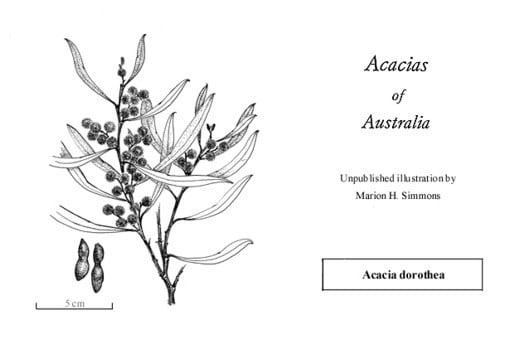Acacia dorothea Maiden
WATTLE
Acacias of Australia
Common Name
Dorothy’s Wattle
Family
Fabaceae
Distribution
Restricted in N.S.W. to the Great Divide from Newnes S to near Robertson.
Description
Shrub usually 1–2 m high, often suckering. Branchlets with indumentum of dense straight closely appressed fine white hairs. New shoots sericeous, with hairs light golden, cream or ±ferruginous, ageing silvery white. Phyllodes ascending to erect, narrowly elliptic to oblanceolate, mostly shallowly incurved, (4–) 5–8 (–10) cm long, (5–) 8–16 (–20) mm wide, acute or obtuse-mucronate, grey-green to subglaucous, with indumentum as on branchlets but ±sparse or rarely absent with age; midrib prominent; lateral nerves obscure; gland rather prominent, not raised, normally 1–3.5 cm above base. Inflorescences racemose; raceme axes (10–) 20–35 (–50) mm long, densely appressed-hairy; peduncles 1.5–3 mm long; heads obloid to shortly cylindrical, (12–) 20–30-flowered, bright golden. Flowers 5-merous; sepals united. Pods narrowly oblong, to 5 cm long, 5–8 mm wide, ±sericeous with silvery white hairs. Seeds (immature) longitudinal.
Habitat
Grows in sand or loam over sandstone, in Eucalyptus forest or woodland.
Specimens
N.S.W.: 3.2 km SW of Mt Wilson, Blue Mtns, R.Coveny 2901 (NSW, PERTH); 0.8 km c. W of the Kangaroo R. Bridge on the Jamberoo–Robertson road, R.Coveny 7342 (NSW); 33.8 km from Clarence on road to Galah Mtn via Newnes State Forest, D.J.McGillivray 1413 (NSW).
Notes
The unusual combination of obloid flower-heads and 1-nerved phyllodes of A. dorothea occurs also in A. lucasii and A. costiniana which differ by generally shorter phyllodes and the nature of their indumentum. The flower-head shape of A. dorothea, along with other characters discussed by M.D.Tindale, Telopea 1: 73 (1975), distinguishes it from A. barringtonensis and its allies.
Acacia dorothea is normally a shrub 1–2 m high, often with a mallee-like habit, but it is sometimes spindly and reaching 3–5 m high.
FOA Reference
Data derived from Flora of Australia Volumes 11A (2001), 11B (2001) and 12 (1998), products of ABRS, ©Commonwealth of Australia
Author
Minor edits by B.R.Maslin & J.Rogers
B.R.Maslin
This identification key and fact sheets are available as a mobile application:
URL: https://apps.lucidcentral.org/wattle/
© Copyright 2018. All rights reserved.








